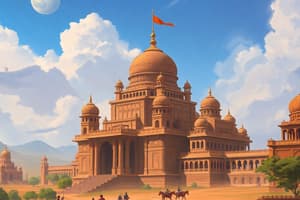Podcast
Questions and Answers
What marked the beginning of Muslim rule in India?
What marked the beginning of Muslim rule in India?
- The founding of the Delhi Sultanate (correct)
- The establishment of the Vijayanagara Empire
- The Mughal Empire's rise to power
- The Battle of Panipat
Which dynasty is NOT included in the Delhi Sultanate?
Which dynasty is NOT included in the Delhi Sultanate?
- Tughlaqs
- Mamluks
- Cholas (correct)
- Khiljis
What is considered a significant architectural contribution from the Delhi Sultanate?
What is considered a significant architectural contribution from the Delhi Sultanate?
- Red Fort
- Hampi
- Alai Darwaza (correct)
- Taj Mahal
Which of the following cultural developments emerged as a result of the fusion of Hindu and Islamic cultures?
Which of the following cultural developments emerged as a result of the fusion of Hindu and Islamic cultures?
Which ruler is NOT associated with the Vijayanagara Empire?
Which ruler is NOT associated with the Vijayanagara Empire?
The region of Hampi is recognized for what major aspect?
The region of Hampi is recognized for what major aspect?
Which statement about the Mughal Empire is accurate?
Which statement about the Mughal Empire is accurate?
Which of the following regions was known for their valor against invaders?
Which of the following regions was known for their valor against invaders?
Which contribution distinguishes the Vijayanagara Empire from contemporary kingdoms?
Which contribution distinguishes the Vijayanagara Empire from contemporary kingdoms?
What was a notable economic achievement of the Delhi Sultanate?
What was a notable economic achievement of the Delhi Sultanate?
Study Notes
Delhi Sultanate
- Established in 1206, marking the start of Muslim rule in India.
- Comprised several dynasties including the Mamluks, Khiljis, Tughlaqs, Sayyids, and Lodis.
- Major contributions:
- Introduction of Persian culture and administration.
- Architectural innovations, e.g., Qutub Minar, Alai Darwaza.
- Economic prosperity through trade and agriculture.
Cultural Developments
- Synthesis of Hindu and Islamic cultures leading to:
- The emergence of forms of literature like Urdu and Hindavi.
- Development of new artistic styles in painting and architecture.
- Spread of Sufi mysticism which influenced social and religious practices.
- Promotion of education through madrasas and established universities.
Vijayanagara Empire
- Founded in 1336, known for its wealth and cultural achievements.
- Key rulers include Harihara I and Bukka Raya I.
- Contributions:
- Advances in art, religion (Hinduism), and architecture (Hampi as a UNESCO site).
- Agricultural innovations and trade across Asia.
- Flourishing of classical music and dance forms.
Regional Kingdoms
- Emergence of diverse political entities during the medieval period:
- Rajput Kingdoms: Known for valor and resistance against invaders.
- Deccan Sultanates: Comprised Berar, Bijaapur, Golconda, and Ahmednagar, promoting local art and culture.
- Kingdoms of Orissa and Bengal: Notable for trade, cultural assimilation, and temple architecture.
Mughal Empire
- Established in 1526 by Babur after the Battle of Panipat.
- Peak under Akbar, Jahangir, Shah Jahan, and Aurangzeb.
- Major achievements:
- Centralized administration and the introduction of policies of religious tolerance (Din-i Ilahi).
- Architectural masterpieces like the Taj Mahal, Red Fort, and Fatehpur Sikri.
- Cultural flourishing with advancements in literature, art, and cuisine, blending Persian and Indian traditions.
Delhi Sultanate
- Founded in 1206 by Qutub-ud-din Aibak, marking the beginning of Muslim rule in India.
- Ruled by five dynasties: Mamluks, Khiljis, Tughlaqs, Sayyids, and Lodis.
- Persian culture significantly influenced the Delhi Sultanate's administration, art, architecture, and literature.
- Notable architectural contributions include the Qutub Minar and Alai Darwaza.
- Economic prosperity during the Sultanate's rule was fueled by trade and agriculture.
Cultural Developments
- A blend of Hindu and Islamic cultures shaped the medieval period:
- The emergence of Urdu and Hindavi as literary languages.
- New artistic styles reflected in painting and architecture.
- Spread of Sufi mysticism, impacting social and religious practices.
- Promotion of education through madrasas and established universities, like the famed Nalanda University.
Vijayanagara Empire
- Founded in 1336, renowned for its wealth and cultural accomplishments.
- Harihara I and Bukka Raya I were key rulers.
- Contributions include advanced art, Hinduism as the dominant religion, and Hampi, a UNESCO World Heritage site.
- The Vijayanagara Empire advanced agriculture, participated in extensive trade across Asia, and fostered classical music and dance forms.
Regional Kingdoms
- Various political entities thrived during the medieval period:
- Rajput Kingdoms known for their valor and resistance against invaders.
- Deccan Sultanates, including Berar, Bijaapur, Golconda, and Ahmednagar, promoted local art and culture.
- Kingdoms of Orissa and Bengal, recognized for their trade, cultural assimilation, and temple architecture.
Mughal Empire
- Founded in 1526 by Babur following the Battle of Panipat against the Lodi dynasty.
- The empire reached its peak under Akbar, Jahangir, Shah Jahan, and Aurangzeb.
- Noteworthy achievements:
- A centralized administration and the policy of religious tolerance, "Din-i Ilahi," promoted by Akbar.
- Architectural masterpieces like the Taj Mahal, Red Fort, and Fatehpur Sikri.
- A flourishing cultural period marked by advancements in literature, art, and cuisine, blending Persian and Indian traditions.
Studying That Suits You
Use AI to generate personalized quizzes and flashcards to suit your learning preferences.
Description
This quiz covers the key historical elements of the Delhi Sultanate and the Vijayanagara Empire. It explores their contributions to culture, architecture, and the synthesis of Hindu and Islamic traditions. Test your knowledge on significant rulers, innovations, and the impact of these empires in Indian history.




